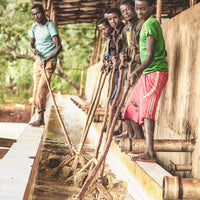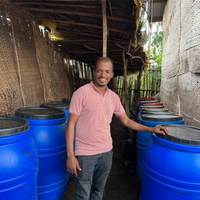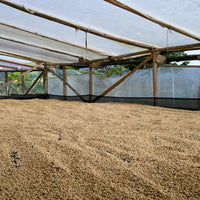Panama Hartmann Caturra Black Winey
Origin: Panama
Region: Chiriqui
Sub Region: Santa Clara, Renacimiento, Candela
Altitude: 1500 meters above sea level
Farm: Hartmann Estate
Owner: Hartmann Family
Variety: Caturra
Process: Black Winey (Natural)
Harvest: December – March
Tasting notes: Sweet, winey and full bodied with notes of preserved fruit, berries and chocolate.
The Black Winey Process is essentially a natural processed coffee where the cherries are picked at an ‘over ripe’ stage. The cherry is picked when it is darker and riper than is typically picked. Cherry is then dried on African raised beds. Cherry is visually inspected to remove damaged or over and under ripes and then laid in thin layers on raised beds. Raised beds allow for better airflow throughout drying that help prevent over-ripening, fermenting or spoiling.
The Hartmann family is considered one of the pioneers of the specialty coffee production in Panama. Their story starts with Alois Strasil Hartmann, born in 1891 in the region of Moravia, then Austrian-Hungarian empire (you might understand our personal affinity to this finca), laid the ground work for Finca Hartmann, which was founded by his son, Ratibor Hartmann, in 1940. Alois came to Panama in 1912 in search of adventure, which made him follow the telegraph lines all the way to Volcan instead of staying in Panama City. He was the first resident of Volcan, where he settled, married Susana Troetsch, daughter of a German immigrant and took care of 2000 cattle and 1000 donkeys for a certain Mr. Landberg. He started a coffee farm and later moved to Santa Clara where he had another coffee farm, but his real interest lay with archeology. He died on May 25th, 1970 at age 78 and is still nowadays remembered/recognized for his knowledge of the zone and panamanian archeology.
For the coffee farm he bought 500has from the Panamanian government and gave 100has of this land with virgin forest to one of his sons, Ratibor Hartmann, who was working with the US army in Panama City and turned that land into the Finca Hartmann coffee farm. In 1966 Ratibor married Dinorah Sandí from Costa Rica. Together they raised 5 children, Ratibor Jr, Allan, Alexander, Aliss and Kelly.
Today Finca Hartmann is a family enterprise – each member of the family is passionately involved in the management and performs a different function in the growth, production and tourism of the farm. Coffee for them is a way of living, their culture, their family – a lot of work, but also a lot of love. Their employees return every year, as do their buyers, because they like their vision: work together with nature, work the land without destroying it. The finca consists of 2 farms – Santa Clara Finca Hartmann and Ojo de Agua, located between 1.300 and 2.000 mts above sea level with nearly 100has of forest reserves bordering on the Parque Nacional de La Amistad. The coffee is grown under the shade of native rainforest trees that have been there for many years. The Hartmanns try not to cut trees, they replant native trees and plantains to maintain the natural cycle and a healthy soil and fauna.
“From the beginning, since my parents started with this farm, they have worked the land with a lot of love and respect. We are following in their footsteps, we love this farm, we love what we do, despite the difficulties one might face in the market, and we intend to pass this passion on to our children.” Aliss Hartmann
“My father always linked the coffee production to the conservation of the environment.” Ratibor Hartmann
Though small in coffee production, Panama is a mighty player in coffee quality. In particular, Panama is famous for producing Geisha variety lots that have fetched prices exceeding $800 per pound. Today, its renown as a producer of rare and sought-after varieties positions Panama as a contender for a new kind of ‘coffee-tourism’ that has the potential to change the way we produce, purchase, consume and talk about specialty coffee on a global scale.
The high value of Geisha has brought out both the best and worst in the industry. For established producers who receive excellent prices for their Geisha and other lots, the high prices they receive have often been reinvested in their communities and in renovating their farms to be as environmentally sustainable as possible. Unfortunately, the lure of Geisha’s high value has led some people bypass traditional land purchasing agreements and illegally deforest areas of national parks to get the best location for new (and illicit) Geisha farms.
Even as the number of producers those receiving high prices for their Geisha remains relatively low, the blossoming coffee industry in Panama has demonstrated potential to raise incomes for a wider spectrum of producers and coffee workers.







